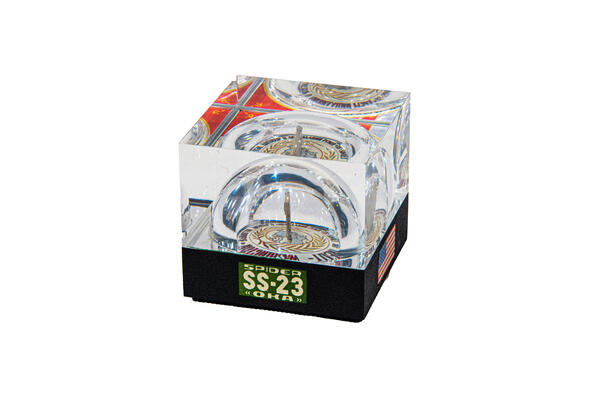The short-range theatre ballistic missile ‘Oka’ (OTR-23) was one of the most successful missiles of the KB Mashinostroyeniya Kolomna (Machine-Building Design Bureau) during the Soviet era.
The development of the army missile system began in the mid-1970s. Soviet designer of rocket weaponry Sergey Nepobedimy was in charge. The Museum of Military Glory houses a souvenir made from a fragment of a destroyed OTR-23 missile. The fragment was placed in a glass cube with an accompanying inscription.
Prior to the development of the OTR-23, another missile system, the 9K72 (Scud), was used for military operations. It was upgraded several times, but over time, it no longer met the technical and tactical requirements.
The new OTR-23 was faster and more accurate. In 1978, at the Kapustin Yar test site, the first flight test of the ‘Oka’ system was carried out; 26 missiles were launched. The tests were successful, and in 1980, the missile system was adopted.
As to its technical characteristics, the OTR-23 was unparalleled in the world. The ballistic missile was fully autonomous and could self-target by switching on radar devices; the system could move on any off-road trails and even overcome water obstacles. Furthermore, it was easy to disguise the ‘Oka’ on the ground. The missile system was light enough that it could be transported by air, rail, or sea if necessary.
By the end of the Cold War, OTR-23 greatly strengthened the Soviet nuclear forces. The ‘Oka’ system could strike small targets and quite large areas, such as other missile and multiple launch rocket systems, long-range artillery, enemy airfields, command posts and communication centers, military outposts and arsenals. The missile system could also fire at moving targets. The ‘Oka’ was classified as a short-range ballistic missile; the maximum range of its flight was 400 kilometers.
The ‘Oka’ system was destroyed in 1987, after the presidents of the USSR and the United States signed the Treaty on the Elimination of Intermediate-Range and Short-Range Missiles. After it was signed, the USSR also stopped the development of an improved version of the OTR-23, the ‘Oka-U’, which was ready for testing by that time. It had a higher accuracy than the previous model. The missile could be controlled during its entire flight and even redirected to hit another target.
The development of the army missile system began in the mid-1970s. Soviet designer of rocket weaponry Sergey Nepobedimy was in charge. The Museum of Military Glory houses a souvenir made from a fragment of a destroyed OTR-23 missile. The fragment was placed in a glass cube with an accompanying inscription.
Prior to the development of the OTR-23, another missile system, the 9K72 (Scud), was used for military operations. It was upgraded several times, but over time, it no longer met the technical and tactical requirements.
The new OTR-23 was faster and more accurate. In 1978, at the Kapustin Yar test site, the first flight test of the ‘Oka’ system was carried out; 26 missiles were launched. The tests were successful, and in 1980, the missile system was adopted.
As to its technical characteristics, the OTR-23 was unparalleled in the world. The ballistic missile was fully autonomous and could self-target by switching on radar devices; the system could move on any off-road trails and even overcome water obstacles. Furthermore, it was easy to disguise the ‘Oka’ on the ground. The missile system was light enough that it could be transported by air, rail, or sea if necessary.
By the end of the Cold War, OTR-23 greatly strengthened the Soviet nuclear forces. The ‘Oka’ system could strike small targets and quite large areas, such as other missile and multiple launch rocket systems, long-range artillery, enemy airfields, command posts and communication centers, military outposts and arsenals. The missile system could also fire at moving targets. The ‘Oka’ was classified as a short-range ballistic missile; the maximum range of its flight was 400 kilometers.
The ‘Oka’ system was destroyed in 1987, after the presidents of the USSR and the United States signed the Treaty on the Elimination of Intermediate-Range and Short-Range Missiles. After it was signed, the USSR also stopped the development of an improved version of the OTR-23, the ‘Oka-U’, which was ready for testing by that time. It had a higher accuracy than the previous model. The missile could be controlled during its entire flight and even redirected to hit another target.



